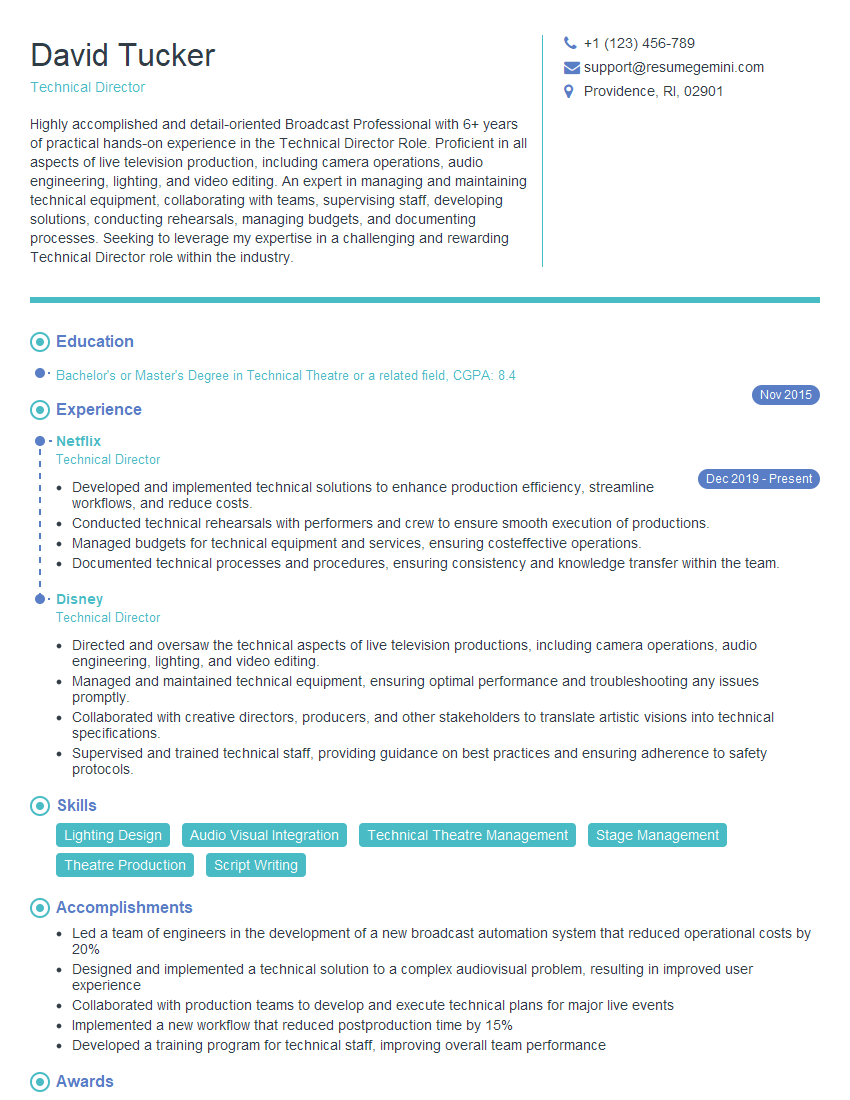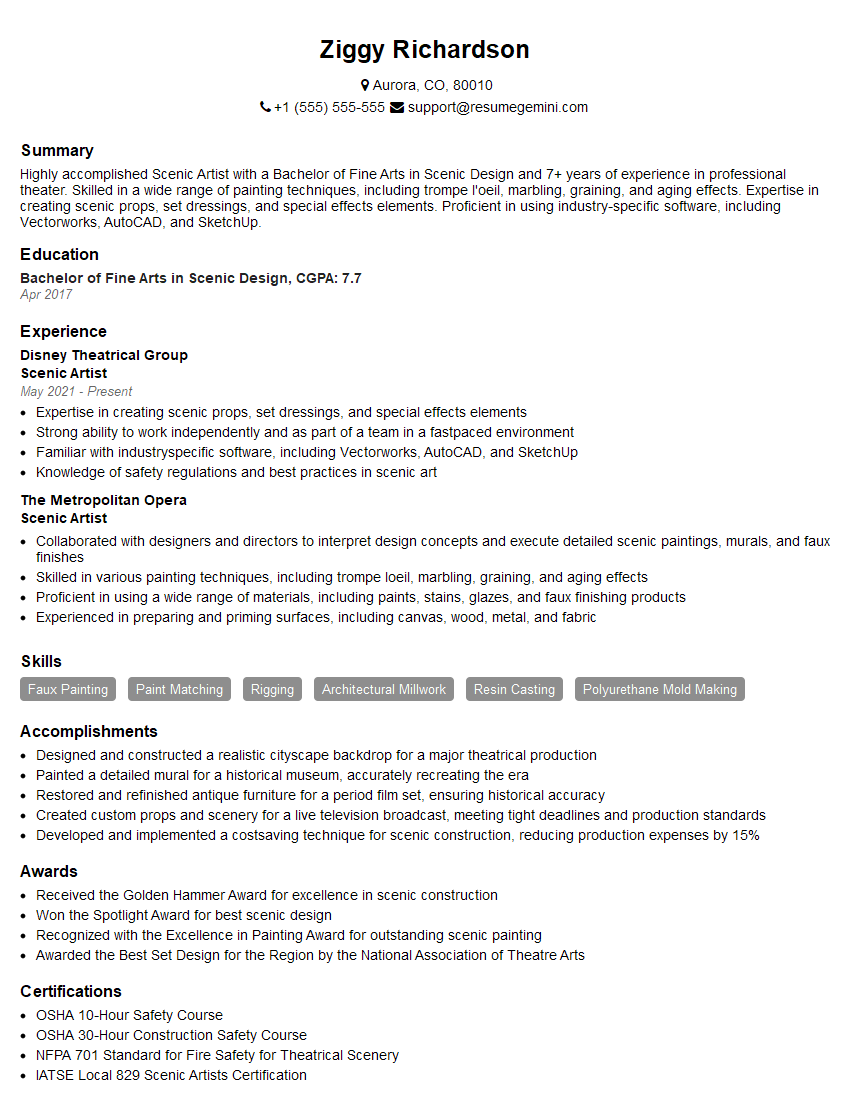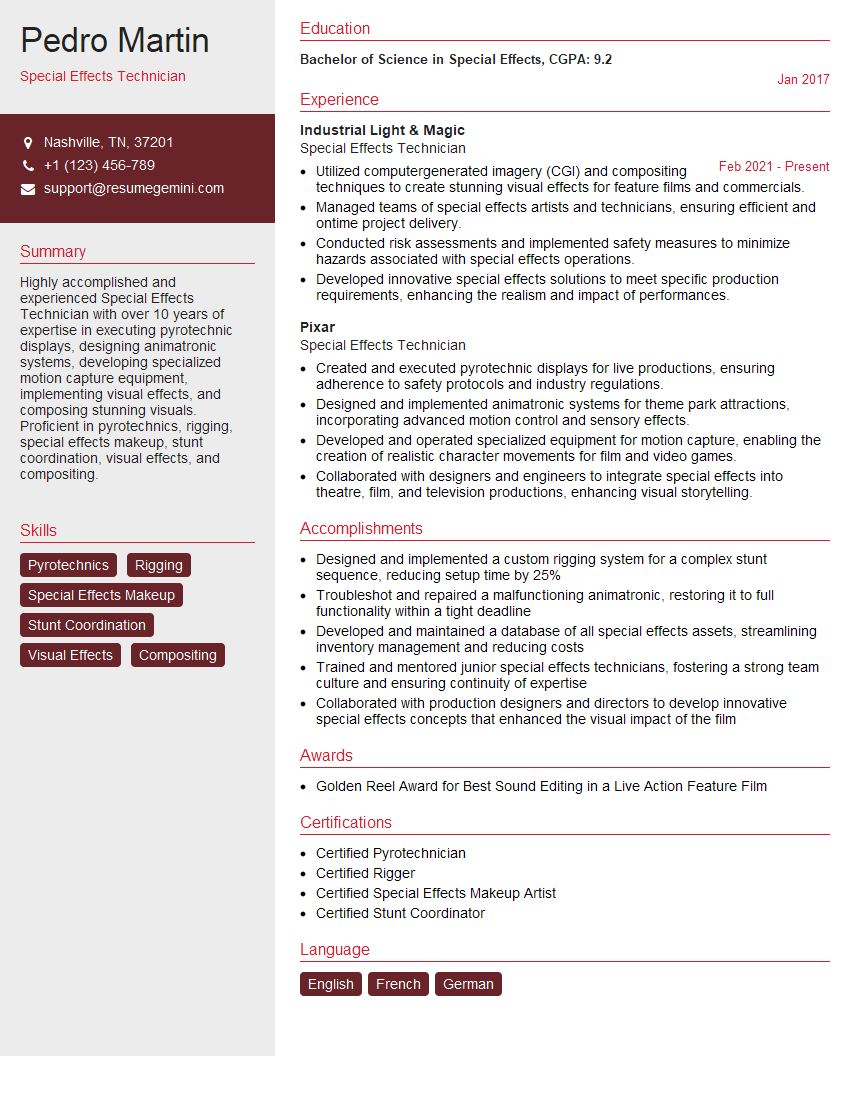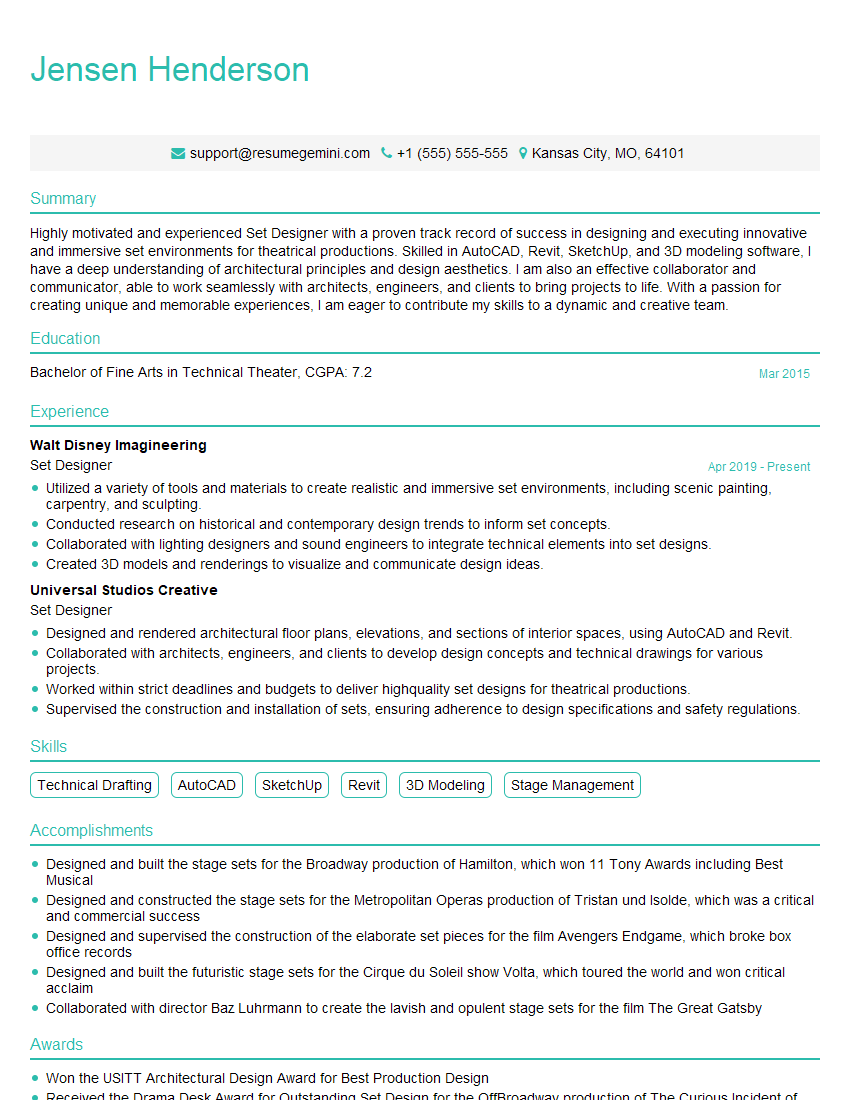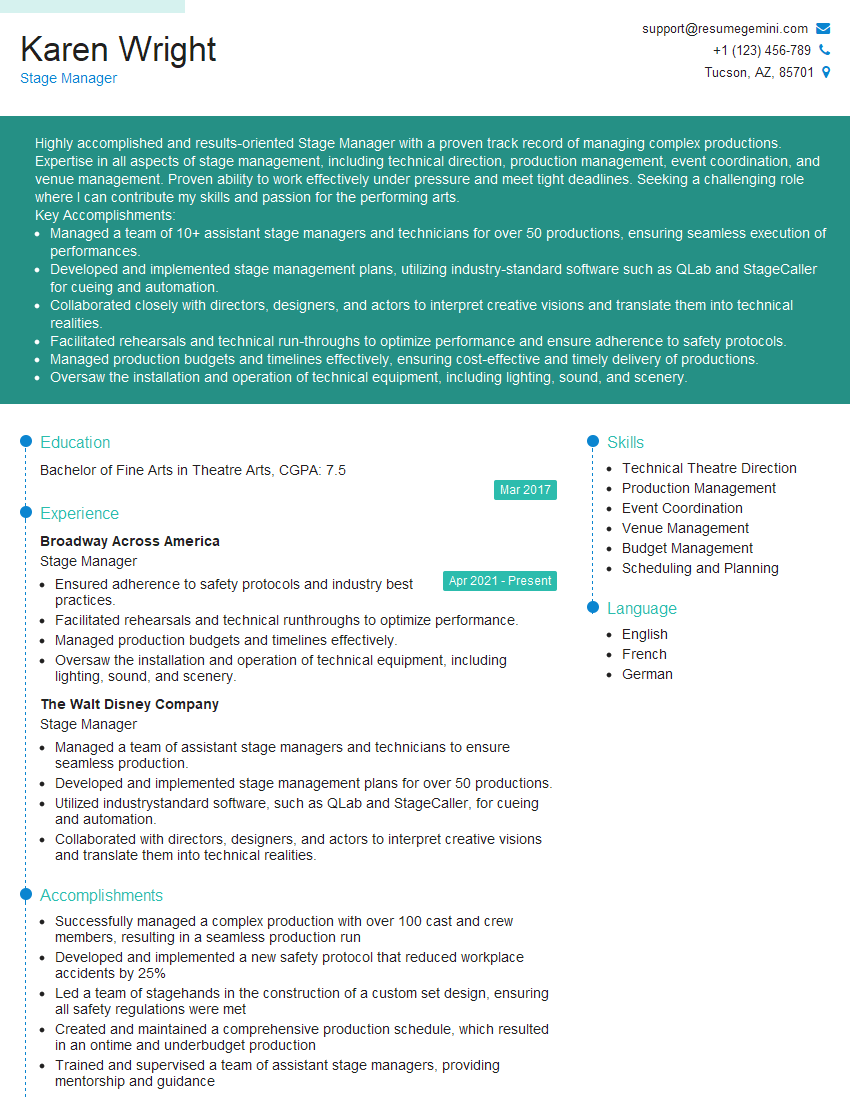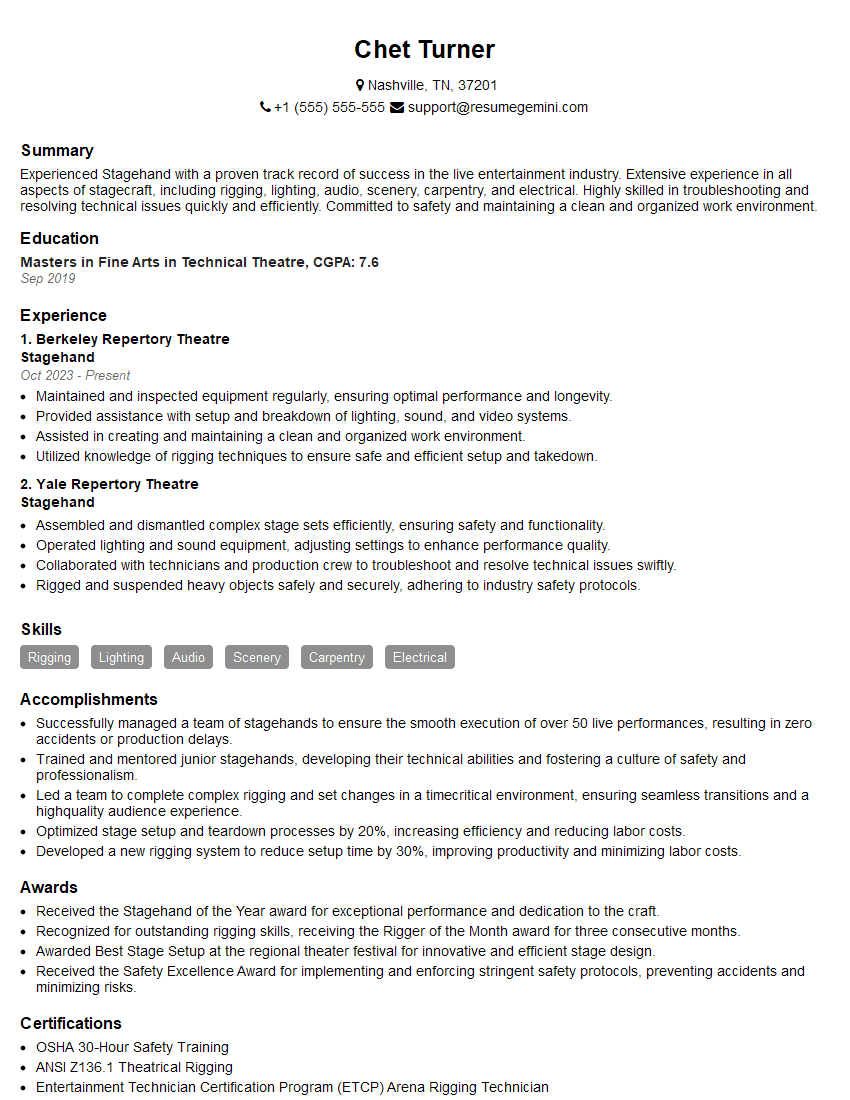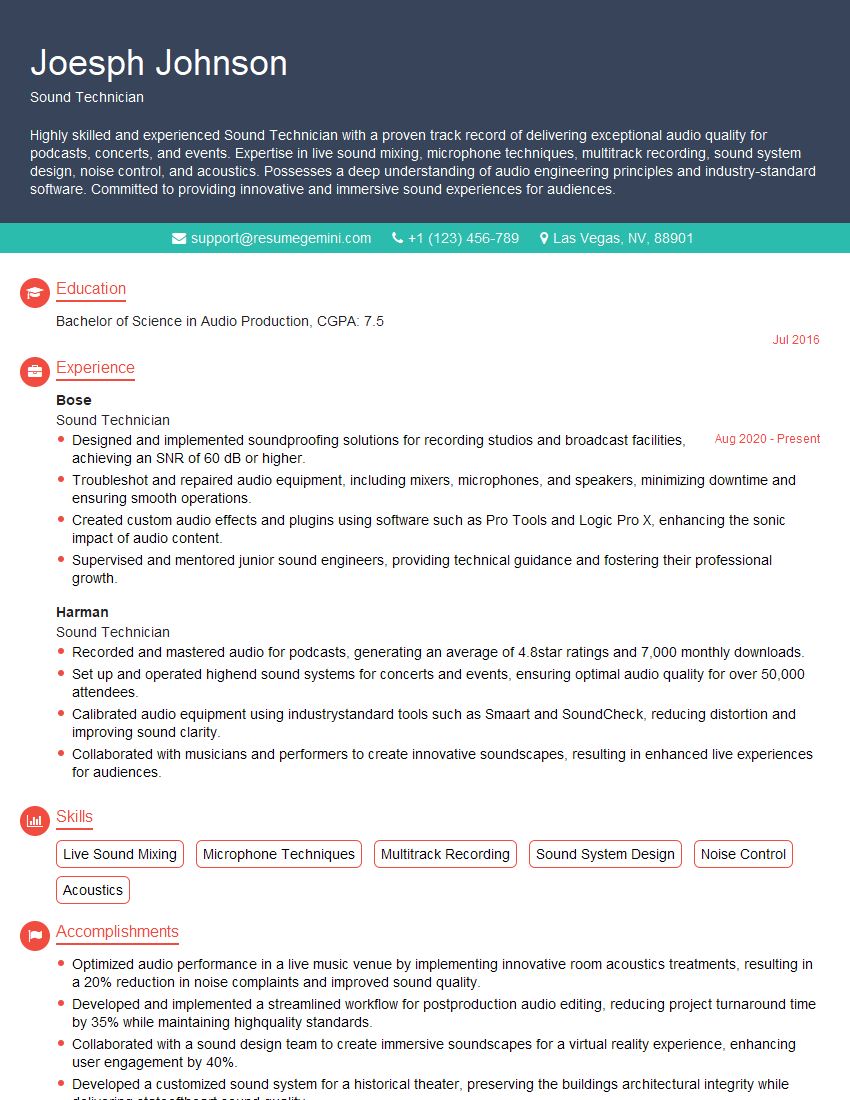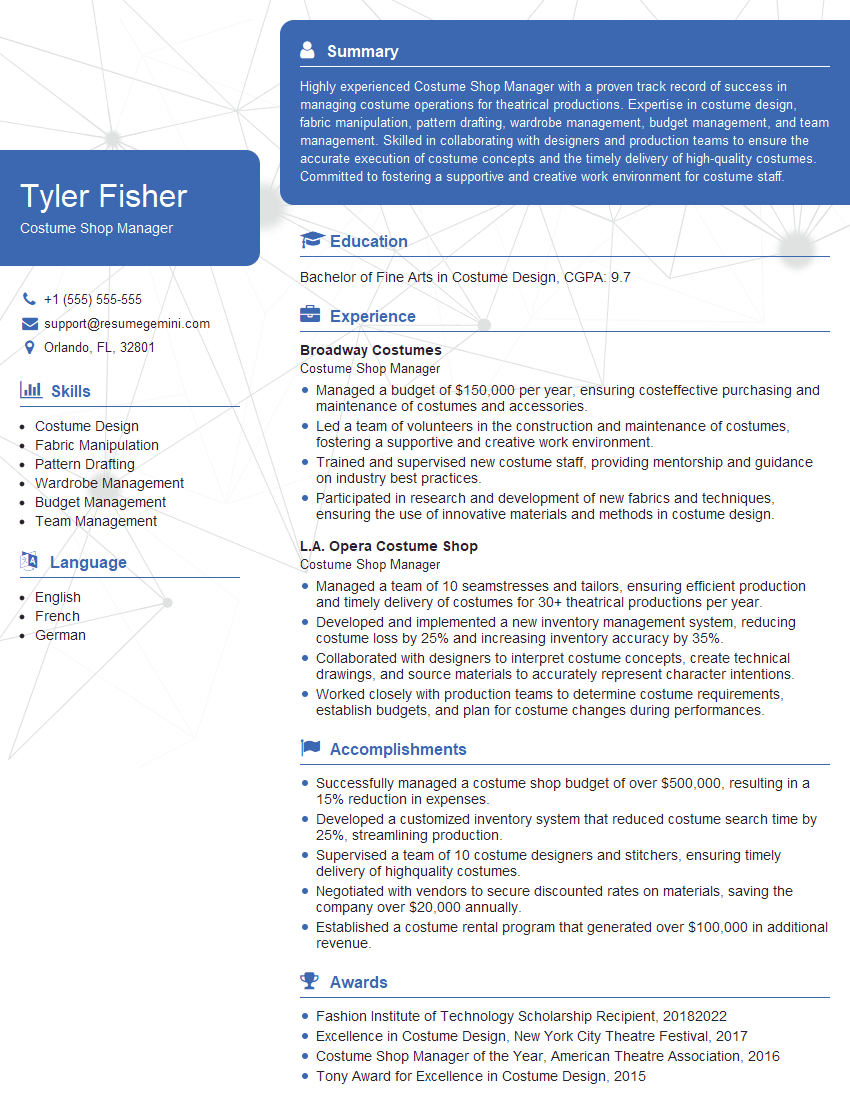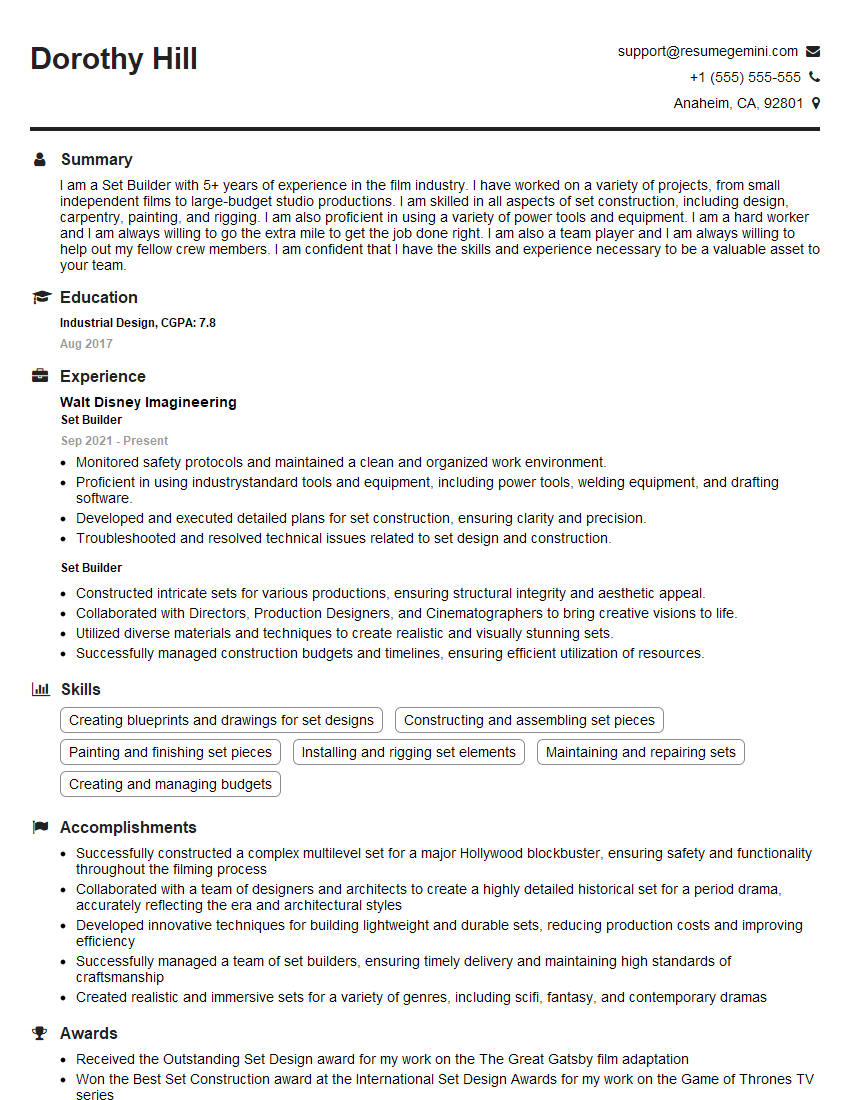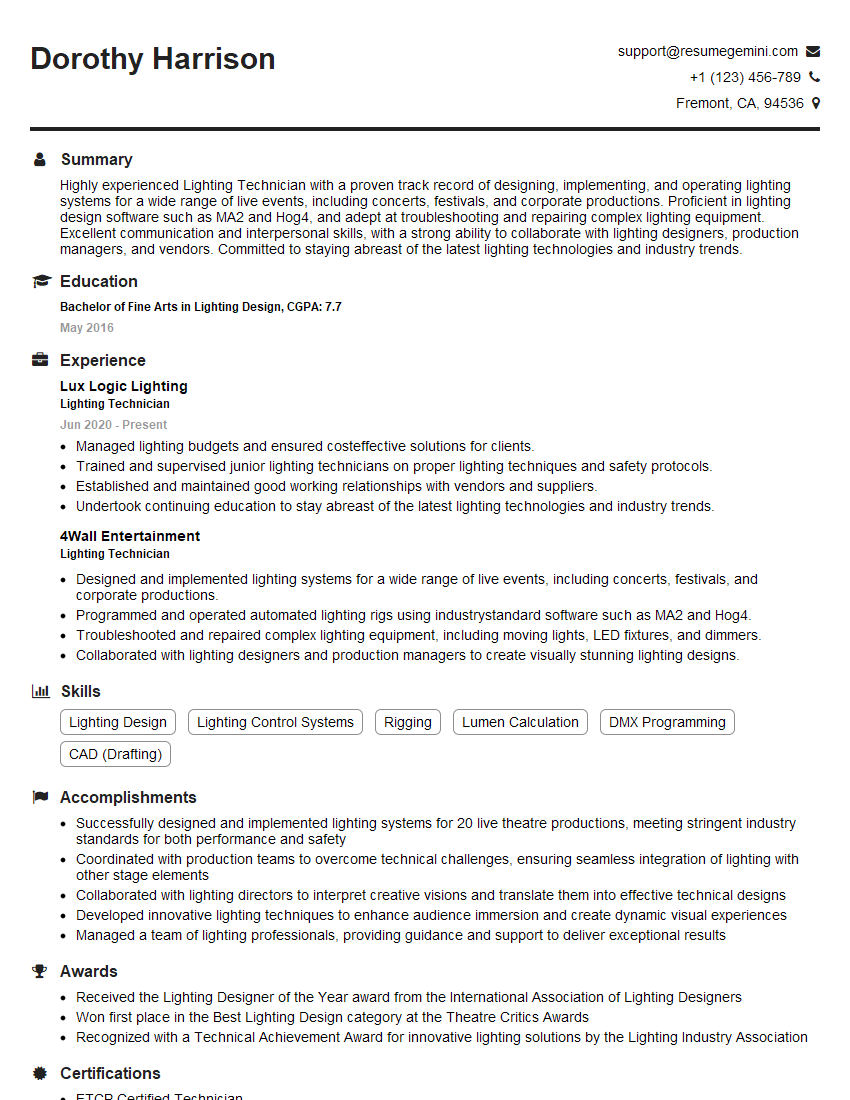Interviews are more than just a Q&A session—they’re a chance to prove your worth. This blog dives into essential Knowledge of Stagecraft and Set Construction interview questions and expert tips to help you align your answers with what hiring managers are looking for. Start preparing to shine!
Questions Asked in Knowledge of Stagecraft and Set Construction Interview
Q 1. Describe your experience with different types of theatrical scenery.
My experience encompasses a wide range of theatrical scenery, from the simplest flat scenery to complex, multi-level constructions. I’ve worked with:
- Traditional flat scenery: These are basic painted panels used to create walls and backgrounds. I’ve constructed countless flats using various materials and techniques, including traditional framing with muslin and modern lightweight alternatives.
- Unit set construction: This involves building modular pieces that can be easily reconfigured for different scenes or shows, allowing for efficient use of resources. I’m adept at designing interlocking units for maximum flexibility.
- Three-dimensional scenery: This includes platforms, stairs, ramps, and other architectural elements. I have experience creating these using wood, metal, and various composite materials, ensuring structural integrity and safety.
- Special effects scenery: I’ve worked with rotating platforms, trap doors, and other moving elements, demanding a strong understanding of mechanics and safety protocols.
- Projected scenery: Utilizing digital projections onto scenic elements to create dynamic and evocative backdrops is something I have significant experience with. This involves coordinating with lighting and projection designers.
Each type presents unique challenges and requires adapting construction methods and materials for optimal results.
Q 2. Explain the process of creating a detailed set design from initial concept to final build.
Creating a set design is a multi-stage process. It begins with:
- Initial Concept: Collaborating with the director and designers to understand the play’s themes, style, and needs. Sketching preliminary ideas and exploring different design options.
- Research and Development: Gathering reference images, researching historical periods or styles, and exploring the practical feasibility of design ideas.
- Sketching and Rendering: Developing detailed sketches, perspective drawings, and possibly 3D renderings to visualize the set design. This helps communicate the vision to the director and construction crew.
- Technical Drawings: Creating detailed scale drawings that precisely specify the dimensions, materials, and construction details for each scenic element. This is essential for the construction phase.
- Construction: Supervising and assisting in the building of the set, ensuring adherence to the technical drawings and maintaining quality control. This involves managing materials, tools, and personnel.
- Installation and Dress: Coordinating the placement and final finishing touches, such as painting, texturing, and prop placement.
Throughout the process, constant communication and collaboration are vital to ensure the set aligns with the director’s vision and the practical limitations of the production.
Q 3. What software programs are you proficient in for set design and drafting?
I’m proficient in several software programs commonly used in set design and drafting, including:
- AutoCAD: For creating precise 2D technical drawings and plans.
- Vectorworks: A powerful software for both 2D and 3D modeling, allowing for detailed visualization and construction documentation.
- SketchUp: A user-friendly 3D modeling program ideal for quick prototyping and visualizing complex designs.
- Adobe Photoshop: For creating textures, rendering, and enhancing visual presentations.
My proficiency in these tools enables me to create accurate, detailed, and visually compelling designs that effectively communicate my ideas and ensure smooth construction.
Q 4. How do you handle unexpected challenges or changes during a production?
Unexpected challenges are a common part of theatre production. My approach involves:
- Problem Assessment: Quickly identify the nature and scope of the challenge.
- Resource Evaluation: Assess available resources, including time, budget, and personnel.
- Creative Problem Solving: Explore alternative solutions, leveraging my knowledge and experience to find practical and efficient workarounds. This often involves improvisation and adapting existing elements.
- Communication: Maintaining clear and consistent communication with the director, designers, and construction crew to ensure everyone is informed and aligned on the revised plan.
- Documentation: Updating plans and documentation to reflect any changes made to ensure consistency throughout the production.
For instance, in one production, a crucial piece of scenery was damaged just before the opening night. By quickly assessing the situation, we were able to adapt a similar existing element and repaint it to match the production style in time for the performance.
Q 5. Describe your experience with different types of wood and their suitability for set construction.
My experience includes working with various types of wood, each with its own strengths and weaknesses in set construction:
- Pine: A relatively inexpensive and easily workable softwood, ideal for framing flats and creating less-stressed structural elements. However, it’s not as durable as hardwoods.
- Birch: A hardwood known for its strength and smooth finish, excellent for detailed work and high-stress applications. It’s more expensive than pine.
- Oak: A strong and durable hardwood, suitable for heavy-duty constructions, though more difficult to work with than pine.
- Plywood: A versatile material consisting of thin layers of wood glued together, ideal for creating strong, lightweight panels for flats and other components. Various grades offer differing levels of strength and surface quality.
Choosing the right wood depends on the specific application, budget constraints, and desired aesthetic. For example, I would use pine for a quickly-constructed flat but opt for oak for a sturdy platform that will support significant weight.
Q 6. What safety precautions do you take when working with power tools and heavy materials?
Safety is paramount in set construction. My practices include:
- Proper Tool Use: Always using power tools according to manufacturer’s instructions, maintaining sharp blades and bits, and wearing appropriate personal protective equipment (PPE).
- PPE: Consistently using safety glasses, hearing protection, dust masks, and appropriate gloves when handling potentially hazardous materials or operating power tools.
- Material Handling: Employing safe lifting techniques for heavy materials, using lifting equipment when necessary, and ensuring proper storage to prevent accidents.
- Work Area Safety: Maintaining a clean and organized workspace, free of tripping hazards, and ensuring adequate lighting.
- Emergency Preparedness: Knowing the location of safety equipment like first-aid kits and fire extinguishers and having a clear emergency plan in place.
Regular safety briefings and adherence to established safety protocols are non-negotiable aspects of my work. Preventing accidents is crucial for the well-being of the entire team.
Q 7. Explain your understanding of theatrical rigging and safety protocols.
Theatrical rigging involves the system of ropes, pulleys, and counterweights used to fly scenery and lighting. Understanding this is vital for creating safe and functional productions. My understanding covers:
- Counterweight Systems: How to use and maintain these systems to safely raise and lower scenery, ensuring proper balance and preventing accidents.
- Rope and Cable Systems: Proper knot tying, inspection techniques, and load-bearing calculations for various rigging systems.
- Safety Protocols: Adhering to all relevant safety regulations and procedures, including regular inspections, load testing, and the use of appropriate safety equipment (harnesses, fall protection).
- Planning and Design: Understanding how rigging requirements impact set design, ensuring designs are structurally sound and compatible with existing rigging systems.
- Emergency Procedures: Developing and implementing plans for emergencies, such as a sudden rope failure or power outage.
Rigging demands a high level of technical expertise and attention to detail, as any failure could have serious consequences. I prioritize safety in all my work involving rigging, following all industry best practices.
Q 8. How do you manage a team of set builders effectively?
Managing a set construction team effectively requires a blend of strong leadership, clear communication, and meticulous organization. I start by establishing clear roles and responsibilities from the outset, ensuring everyone understands their contribution to the overall project. This often involves detailed task assignments and timelines, visually represented through Gantt charts or similar project management tools. Regular team meetings are crucial – daily stand-ups to address immediate concerns and weekly progress meetings to review milestones and adjust schedules as needed. I foster a collaborative environment where team members feel comfortable voicing concerns or suggesting improvements. Open communication is key; I encourage questions and make myself readily available to provide guidance and support. I also prioritize safety, conducting thorough safety briefings and enforcing strict adherence to safety protocols. For example, on a recent large-scale production, I implemented a color-coded system for identifying different types of hazards and safety equipment, making it instantly clear to everyone on the team. This proactive approach minimized accidents and improved overall efficiency.
Q 9. What are your preferred methods for measuring, cutting, and assembling set pieces?
Accurate measuring, cutting, and assembling are fundamental to successful set construction. My preferred method begins with meticulous planning. I always work from detailed scale drawings, ensuring the team understands the precise dimensions and specifications of each set piece. For measuring, I utilize a combination of tape measures, laser measurers, and digital levels to ensure accuracy. Cutting materials such as wood, plywood, and metal relies on precision tools – miter saws for angled cuts, circular saws for straight cuts, and specialized tools for intricate shapes. I always double-check measurements before making any cuts. Assembly typically follows a modular approach, pre-assembling smaller components before joining them to create larger sections. This allows for better quality control and easier handling of the larger pieces. The use of joinery techniques – such as mortise and tenon, dowel joints, or even metal brackets – depends on the materials and structural requirements of the set. For example, in a recent project involving a complex multi-level set, we pre-fabricated individual sections off-site, ensuring precise measurements and minimizing on-site assembly time and potential errors.
Q 10. Describe your experience with scenic painting techniques and materials.
Scenic painting is an integral part of set design, adding depth, realism, and visual interest. My experience encompasses a wide range of techniques, from basic washes and dry brushing to more advanced methods like sponging, stippling, and glazing. I’m proficient with various painting materials including acrylics, latex, and oil-based paints, each with its own unique properties and applications. Acrylics offer versatility and quick drying times, perfect for fast-paced productions. Latex paints provide durability and are often used for large surface areas. Oil paints allow for a richer depth of color and blending capabilities, especially beneficial for creating realistic textures. I also have experience with applying specialized finishes like faux finishes (e.g., marble, wood grain) and using stencils to create repeating patterns. For example, on a recent historical drama, I used a combination of layering techniques and glazing with oil paints to create the weathered look of aged stone walls, creating a highly believable and atmospheric effect.
Q 11. How do you ensure the structural integrity and stability of a set?
Ensuring structural integrity and stability is paramount in set construction; safety is the top priority. This involves careful consideration of the materials, design, and construction methods. We begin by selecting robust and appropriate materials, considering their load-bearing capacity and resistance to stress. The design itself must be structurally sound, incorporating bracing, reinforcement, and appropriate joinery techniques. Regular checks during the construction process, including visual inspections and load tests where necessary, help to identify and address any potential issues early on. For example, when building a large platform, we’ll use engineered lumber or steel supports, ensuring the platform is appropriately braced to support the anticipated weight and prevent sagging or collapse. Proper anchoring of the set to the stage floor is also critical, utilizing appropriate fasteners and techniques to prevent movement or tipping. We frequently use safety harnesses and other fall protection measures when working at heights.
Q 12. Explain your understanding of weight distribution and load-bearing capacity in set construction.
Understanding weight distribution and load-bearing capacity is crucial for preventing structural failure. This involves calculating the weight of each set piece and distributing it evenly across the supporting structure. I consider factors such as the weight of the materials, the size and shape of the set piece, and the type of support system used. For example, a heavy backdrop might require additional support beams or bracing to prevent sagging or collapse. This calculation requires an understanding of the load-bearing capacity of various materials. Knowing the maximum weight a particular type of wood or steel can safely support is essential to designing a secure structure. Software like structural analysis programs can be used for complex designs, but even with simpler sets, careful consideration of weight distribution is critical. An uneven distribution can lead to undue stress on certain areas of the support structure, increasing the risk of failure.
Q 13. Describe your experience working with different types of fabrics and their application in set design.
Fabrics play a vital role in set design, adding texture, color, and visual interest. My experience includes working with a wide range of fabrics, from lightweight silks and chiffons to heavier velvets and canvas. The choice of fabric depends on the specific application – lightweight fabrics might be used for drapes or flowing curtains, while heavier fabrics could be used for upholstery or wall coverings. I consider the drape and texture of the fabric, as well as its durability and flammability rating. Flame-retardant fabrics are essential for safety reasons, especially in theatrical settings. Techniques for working with fabrics include sewing, draping, and stapling; using specialized tools like sewing machines, staple guns, and heat guns to create different effects. For instance, in a recent production, I used a combination of sheer fabrics and heavier velvet drapes to create a sense of grandeur and depth in a ballroom scene. This required careful planning and execution of the draping and lighting to achieve the desired visual effect.
Q 14. What is your experience with prop construction and sourcing?
Prop construction and sourcing is a significant part of set design. My approach involves a careful balance of building props from scratch and sourcing them from existing resources. I often start by reviewing the script and design drawings to determine the types and quantities of props needed. If custom-built props are required, I’ll create detailed plans, select appropriate materials, and build the props using woodworking, metalworking, or other relevant skills. For example, I recently built a complex, ornate clock for a period drama using wood, metal, and resin. Sourcing existing props often involves researching antique shops, prop houses, and online marketplaces. Finding suitable pre-made props can save time and resources while adding authenticity. The selection process involves considering the style, condition, and suitability of each prop for the specific scene. Often a combination of custom-built and sourced props is the most efficient and effective approach, allowing for both creative control and cost-effectiveness.
Q 15. How familiar are you with different types of lighting instruments and their applications?
My familiarity with lighting instruments is extensive. I’m proficient in using a wide range of instruments, from the basic Fresnel and ellipsoidal spotlights to more specialized units like LED pars, moving heads, and cyclorama lighting. Each has unique applications.
- Fresnel: Excellent for soft, diffused washes, often used for backlighting or creating a warm ambient glow. I’ve used Fresnels extensively in creating mood lighting for intimate scenes in various plays.
- Ellipsoidal (Leko): Produces a sharp, focused beam, ideal for highlighting specific actors or objects. I’ve employed Lekos frequently for precise lighting cues, such as spotlighting a character during a dramatic monologue.
- LED Pars: Energy-efficient and versatile, offering a wide range of colors and dimming capabilities. These are great for quick changes and filling in gaps in lighting.
- Moving Heads: Allow for dynamic and complex lighting effects, perfect for concert settings or fast-paced scenes. I’ve used these successfully in several musical theater productions to create exciting chase effects.
- Cyclorama Lighting: Used to illuminate a cyclorama (a large, curved backdrop), creating atmospheric effects like sunsets or starry nights. I designed a stunning aurora borealis effect using a combination of cyclorama lighting and color filters for a recent production.
Understanding the color temperature, beam angle, and intensity control of each instrument is crucial for effective stage lighting. I always prioritize safety and ensure all lighting equipment is correctly rigged and operated according to industry standards.
Career Expert Tips:
- Ace those interviews! Prepare effectively by reviewing the Top 50 Most Common Interview Questions on ResumeGemini.
- Navigate your job search with confidence! Explore a wide range of Career Tips on ResumeGemini. Learn about common challenges and recommendations to overcome them.
- Craft the perfect resume! Master the Art of Resume Writing with ResumeGemini’s guide. Showcase your unique qualifications and achievements effectively.
- Don’t miss out on holiday savings! Build your dream resume with ResumeGemini’s ATS optimized templates.
Q 16. Explain your experience with sound design and reinforcement techniques.
My experience with sound design and reinforcement encompasses both the technical and artistic aspects. I’m adept at using sound mixing consoles, microphones, speakers, and signal processing equipment to create an immersive soundscape that enhances the storytelling and overall theatrical experience.
In a recent production, I collaborated with the sound designer to develop a soundscape that moved seamlessly from a quiet, intimate setting to an explosive climax. We utilized a combination of ambient sounds, Foley effects (sound effects created live), and pre-recorded music to achieve this. We worked closely to ensure the sound system was perfectly balanced across different areas of the theater, delivering clear audio to the audience regardless of their seating location. This involved careful microphone placement, equalization, and sound level management.
I’m also experienced in troubleshooting audio issues. For example, during a live performance, I once had to quickly identify and resolve a feedback loop caused by a microphone being too close to a speaker. This required quick thinking and familiarity with sound system components to adjust the gain and phase settings effectively.
Q 17. How do you collaborate with lighting and sound designers to integrate their elements into the set design?
Collaboration is key. From the initial design phase, I work closely with lighting and sound designers to ensure seamless integration of their elements into the set design. This involves open communication and regular meetings where we discuss the overall aesthetic vision, technical requirements, and potential challenges.
For instance, I’ll ensure that lighting fixtures have sufficient space and access for rigging and that sound equipment can be discreetly integrated into the set without compromising its structural integrity or visual appeal. We may create scale models or use digital design software to visualize how the set, lighting, and sound will interact. Compromise is essential. The set might need to accommodate a specific lighting effect, requiring adjustments to the original design, or sound reinforcement might dictate the placement of certain set pieces. The success of the production relies heavily on this collaborative approach.
Q 18. What are your problem-solving skills in relation to set construction challenges?
Problem-solving is inherent to set construction. I approach challenges systematically. My process typically involves:
- Identifying the problem: Clearly define the challenge, gathering all relevant information.
- Brainstorming solutions: Explore various approaches, considering different materials, techniques, and resources.
- Evaluating options: Assess the feasibility, cost, and time implications of each solution.
- Implementing the chosen solution: Execute the plan, ensuring safety and quality control.
- Documenting the process: Record the solution and its outcome for future reference.
For example, during a recent production, we faced a shortage of specific lumber due to supply chain issues. I brainstormed alternatives, eventually finding a suitable substitute that was both aesthetically pleasing and structurally sound. This involved researching various wood types, assessing their strength and cost, and confirming their suitability with the design team.
Q 19. How do you adhere to a production’s budget and timeline?
Adhering to budget and timeline is paramount. I use project management techniques such as creating detailed budgets and schedules to ensure efficient resource allocation. This includes:
- Detailed Budgeting: Breaking down the cost of materials, labor, and equipment meticulously.
- Precise Scheduling: Creating a timeline with milestones and deadlines, factoring in potential delays.
- Regular Monitoring: Tracking expenses and progress throughout the project, making adjustments as needed.
- Value Engineering: Finding cost-effective alternatives without compromising quality or safety.
For example, when facing a budget constraint on a recent show, I explored less expensive materials without compromising structural integrity and then strategically allocated the labor, prioritizing tasks that were critical to the show’s success.
Q 20. Describe your experience with different types of stage floors and their installation.
My experience encompasses various stage floors, including sprung, Marley, and composite floors. Each has distinct properties and installation requirements.
- Sprung Floors: These are essential for dance performances, providing shock absorption and resilience. Installation involves a subfloor with a system of interconnected springs to create a flexible surface. Careful measurements and precise installation are vital to prevent unevenness.
- Marley Floors: A type of vinyl flooring, Marley is commonly used for its durability and ease of installation. It’s frequently laid over a subfloor, requiring careful taping and securing to create a smooth, seamless surface. I’ve often used Marley for its versatility in different types of productions, and its relative ease of maintenance compared to other types of flooring.
- Composite Floors: Combining different materials, such as plywood and vinyl, these offer customized solutions. Their installation depends heavily on the specific design and requires attention to detail to create a structurally sound and level surface.
Understanding the specific needs of the production is key. For example, a musical with extensive dance numbers would necessitate a sprung floor, while a drama might only need a simpler Marley floor. Careful consideration of the type of performance and the budget guides the selection and installation.
Q 21. How do you manage inventory and maintain tools and equipment?
Maintaining inventory and tools is crucial for efficient workflow and cost management. I implement a comprehensive system of inventory tracking and equipment maintenance, including:
- Detailed Inventory Database: A digital record of all tools, equipment, and materials, including their condition and location.
- Regular Inspections: Routine checks of tools and equipment to identify any damage or wear and tear.
- Preventive Maintenance: Regular servicing and repairs to extend the lifespan of equipment.
- Proper Storage: Organizing tools and materials in a safe and accessible manner to prevent loss or damage.
This helps to reduce costs associated with replacing damaged or lost equipment, and prevent delays during production caused by missing tools. A well-maintained inventory system ensures efficient resource allocation, enhancing overall productivity and reducing downtime.
Q 22. What is your experience with stage automation systems?
My experience with stage automation systems encompasses a wide range of technologies, from simple counterweight systems to complex computerized fly systems and automated track systems. I’ve worked extensively with both older, mechanically-driven systems requiring meticulous manual operation and adjustment, and newer, computer-controlled systems that allow for precise, programmable movement and sequencing. For example, on a recent production of Hamlet, I oversaw the integration of a computerized fly system to create a dramatic reveal of the ghost. This involved careful programming of the system to ensure smooth, synchronized movement of multiple scenic elements. In another project, we used a motorized turntable to create seamless transitions between different set locations, saving valuable time during scene changes and enhancing the fluidity of the performance. My expertise also extends to troubleshooting and maintenance of these systems, ensuring their reliable performance during productions.
- Experience with Counterweight Systems: I have a deep understanding of the physics and mechanics involved in the design, installation and operation of counterweight systems, including load balancing and safety procedures.
- Experience with Computerized Fly Systems: I am proficient in programming and operating various computerized fly systems, including the creation of cue sheets and the management of safety protocols.
- Experience with Automated Track Systems: I have experience installing, maintaining and operating automated track systems for set pieces and scenery.
Q 23. Describe your experience with special effects (e.g., pyrotechnics, fog, etc.)
My experience with special effects is extensive and includes pyrotechnics, fog, lighting effects, and atmospheric effects like snow or rain. Safety is always paramount. On one production, we utilized a complex pyrotechnics sequence that required close coordination with the fire marshal and rigorous safety checks before, during and after every performance. We meticulously planned the placement and timing of each pyrotechnic effect to ensure both the safety of the cast and crew, and the dramatic impact of the sequence. Proper ventilation is crucial for fog effects. In another show, we used a low-lying fog effect to create an eerie atmosphere. To avoid problems with visibility, we worked with the lighting designer to create a lighting scheme that enhanced rather than obscured the effect. We always choose fog machines with appropriate safety certifications and use them in accordance with manufacturer’s guidelines. I understand the importance of risk assessment and the necessary safety protocols for each effect.
- Pyrotechnics: I am experienced in planning, executing, and supervising pyrotechnic effects, adhering strictly to all safety regulations and licensing requirements.
- Atmospheric Effects: I have experience creating and managing atmospheric effects such as fog, snow, and rain, ensuring their safe and effective integration into the production.
- Lighting Effects: I collaborate closely with lighting designers to integrate special effects into the overall lighting design, enhancing the dramatic impact of the scene.
Q 24. How do you ensure compliance with building codes and safety regulations?
Ensuring compliance with building codes and safety regulations is a top priority. I always begin by obtaining and thoroughly reviewing all relevant building codes and fire safety regulations for the specific venue. This includes understanding local ordinances and any venue-specific requirements. Throughout the design and construction phases, I actively consult with the appropriate authorities to ensure adherence to these regulations. For instance, I ensure that all materials used meet fire safety standards and that all electrical work is performed by licensed electricians in compliance with electrical codes. We create detailed safety plans for potentially hazardous elements like pyrotechnics and ensure that the set design doesn’t compromise access for emergency exits. Regular inspections are conducted, and thorough documentation is maintained throughout the process to demonstrate compliance. We use materials with appropriate certifications to ensure compliance and we submit necessary documentation to the authorities.
- Thorough Research and Documentation: Thoroughly research applicable building codes and safety regulations for each project and maintain comprehensive documentation of all compliance measures.
- Regular Inspections: Conduct regular safety checks and inspections throughout the construction and operational phases.
- Collaboration with Authorities: Maintain consistent communication and collaboration with local authorities, fire marshals, and other regulatory bodies.
Q 25. Explain your process for creating detailed construction drawings and specifications.
Creating detailed construction drawings and specifications is a meticulous process that begins with a comprehensive understanding of the design concept. I use CAD software, such as AutoCAD or Vectorworks, to create detailed scale drawings of the set, including elevations, sections, and plans. These drawings clearly indicate all dimensions, materials, and construction details. Specifications complement the drawings, providing detailed information on materials, finishes, and construction methods. This includes things like wood types, paint colors, hardware specifications, and any special requirements. For complex pieces, I may create separate detailed drawings and specifications. For example, for a large, intricately carved piece, I would create separate drawings for the overall structure and for the detailed carving work. I always ensure that the drawings are clear, concise and easily understood by the construction team, and often include rendered images or 3D models to better visualize the final result. The specifications are similarly detailed, ensuring that the materials are compatible, and easily sourced. This detailed approach minimizes errors and ensures the set is built to the designer’s vision.
- CAD Software: Utilize professional-grade CAD software (e.g., AutoCAD, Vectorworks) to create precise, detailed scale drawings.
- Detailed Specifications: Create detailed material and construction specifications to accompany the drawings, ensuring clarity and consistency.
- Collaboration and Review: Collaborate with the design team and construction team to ensure that the drawings and specifications are understood and achievable.
Q 26. Describe your experience with different joinery techniques in wood construction.
My experience with joinery techniques encompasses a broad range, including mortise and tenon, dovetail, dado, rabbet, and miter joints. The choice of joint depends on the specific application and the required strength and aesthetic. For example, I would use mortise and tenon joints for heavier duty applications where strength is paramount, like building a large frame, whereas a dovetail joint might be more appropriate for drawers or smaller, more intricate pieces. Rabbet and dado joints are commonly used for framing and shelving. I’m adept at both traditional hand-cut joinery and machine-assisted techniques, utilizing tools such as routers, table saws, and jointers to achieve precision and efficiency. I understand the importance of using appropriate adhesives and fasteners to enhance joint strength and durability. My training includes understanding the grain direction and the properties of different wood types to optimize the effectiveness and longevity of each joint. This ensures the structural integrity of the constructed set elements.
- Mortise and Tenon: Proficient in creating strong, durable mortise and tenon joints for structural elements.
- Dovetail: Skilled in creating aesthetically pleasing and strong dovetail joints for drawer construction and fine details.
- Dado and Rabbet: Experienced in utilizing dado and rabbet joints for framing and shelving.
Q 27. How do you communicate effectively with directors, designers, and other crew members?
Effective communication is crucial in stagecraft and set construction. I approach this by actively listening to understand the vision of the director and designer, asking clarifying questions to ensure I fully grasp their expectations. I then translate that vision into clear, concise instructions for the construction crew. I use a variety of communication methods—from formal written documentation (drawings, specifications, schedules) to informal discussions and daily briefings. I foster a collaborative environment where everyone feels comfortable voicing concerns or suggestions. I also use visual aids such as mock-ups or 3D models to clarify complex design elements. Regular meetings and progress reports keep the entire team informed. In addition, I make sure to maintain professional relationships with everyone on the team, acknowledging their hard work and contributions and making sure to address any problems that arise openly and honestly. In essence, my goal is to create a team environment where everybody works together effectively to achieve our shared goal.
- Active Listening: Actively listen to and understand the vision of directors and designers.
- Clear Communication: Communicate clearly and concisely to the construction crew through various methods.
- Collaboration: Foster a collaborative environment that encourages open communication and problem-solving.
Q 28. What are your career goals within the field of stagecraft and set construction?
My career goals center on continued growth and leadership within the field of stagecraft and set construction. I aim to refine my skills in project management and oversee increasingly complex and ambitious productions. I’m interested in exploring advanced technologies and automation systems, including virtual and augmented reality applications in set design and construction. Eventually, I aspire to lead a team of skilled professionals, mentoring and training the next generation of stagecraft artisans. I’m also interested in exploring opportunities to contribute to innovative set designs that push the boundaries of theatrical production and offer unique audience experiences. This encompasses developing my skills in sustainable and environmentally-conscious construction methods, ensuring that my work has a positive impact on the environment.
- Project Management: To develop my leadership skills and manage larger, more complex projects.
- Technological Advancement: To stay abreast of and integrate cutting-edge technologies into set design and construction.
- Mentorship and Training: To mentor and train upcoming professionals in the field of stagecraft.
Key Topics to Learn for Knowledge of Stagecraft and Set Construction Interview
- Blueprint Reading and Interpretation: Understanding technical drawings, scale models, and construction documents. Practical application: Accurately translating 2D plans into 3D structures.
- Materials and Construction Techniques: Knowledge of various materials (wood, metal, fabrics, plastics) and their properties, along with safe and efficient construction methods. Practical application: Selecting appropriate materials for specific design needs and constructing durable and safe set pieces.
- Tools and Equipment: Familiarity with hand tools, power tools, and specialized equipment used in set construction. Practical application: Demonstrating safe and proficient use of relevant tools for specific tasks.
- Safety Procedures and Regulations: Understanding and adhering to workplace safety protocols, including hazard identification and risk mitigation. Practical application: Implementing safety measures during construction and maintenance of sets.
- Stage Mechanics and Rigging: Knowledge of basic stage mechanics, including fly systems, counterweights, and rigging techniques. Practical application: Understanding weight distribution and load calculations for safe rigging operations.
- Budgeting and Resource Management: Estimating material costs, labor hours, and overall project budgeting. Practical application: Efficiently managing resources to stay within budget constraints.
- Collaboration and Teamwork: Understanding the importance of effective communication and collaboration within a design and construction team. Practical application: Working effectively with designers, technicians, and other crew members.
- Problem-Solving and Troubleshooting: Ability to identify and resolve construction challenges, adapting to unexpected issues on the job. Practical application: Finding creative solutions to construction problems while maintaining schedule and safety.
Next Steps
Mastering stagecraft and set construction opens doors to exciting and varied career paths within theatre, film, television, and events. A strong understanding of these skills is highly valued by employers. To maximize your job prospects, it’s crucial to present your skills effectively. Creating an ATS-friendly resume is key to getting your application noticed. We highly recommend using ResumeGemini to build a professional and impactful resume that highlights your expertise. ResumeGemini offers examples of resumes tailored to Knowledge of Stagecraft and Set Construction, giving you a head start in showcasing your abilities to potential employers.
Explore more articles
Users Rating of Our Blogs
Share Your Experience
We value your feedback! Please rate our content and share your thoughts (optional).
What Readers Say About Our Blog
Hello,
We found issues with your domain’s email setup that may be sending your messages to spam or blocking them completely. InboxShield Mini shows you how to fix it in minutes — no tech skills required.
Scan your domain now for details: https://inboxshield-mini.com/
— Adam @ InboxShield Mini
Reply STOP to unsubscribe
Hi, are you owner of interviewgemini.com? What if I told you I could help you find extra time in your schedule, reconnect with leads you didn’t even realize you missed, and bring in more “I want to work with you” conversations, without increasing your ad spend or hiring a full-time employee?
All with a flexible, budget-friendly service that could easily pay for itself. Sounds good?
Would it be nice to jump on a quick 10-minute call so I can show you exactly how we make this work?
Best,
Hapei
Marketing Director
Hey, I know you’re the owner of interviewgemini.com. I’ll be quick.
Fundraising for your business is tough and time-consuming. We make it easier by guaranteeing two private investor meetings each month, for six months. No demos, no pitch events – just direct introductions to active investors matched to your startup.
If youR17;re raising, this could help you build real momentum. Want me to send more info?
Hi, I represent an SEO company that specialises in getting you AI citations and higher rankings on Google. I’d like to offer you a 100% free SEO audit for your website. Would you be interested?
Hi, I represent an SEO company that specialises in getting you AI citations and higher rankings on Google. I’d like to offer you a 100% free SEO audit for your website. Would you be interested?
good
